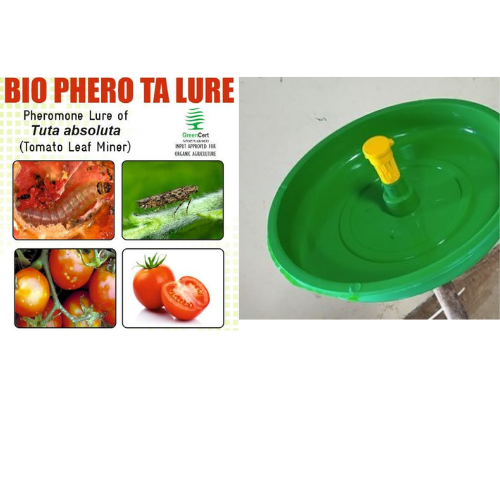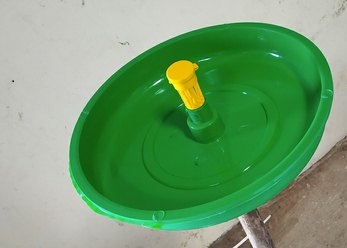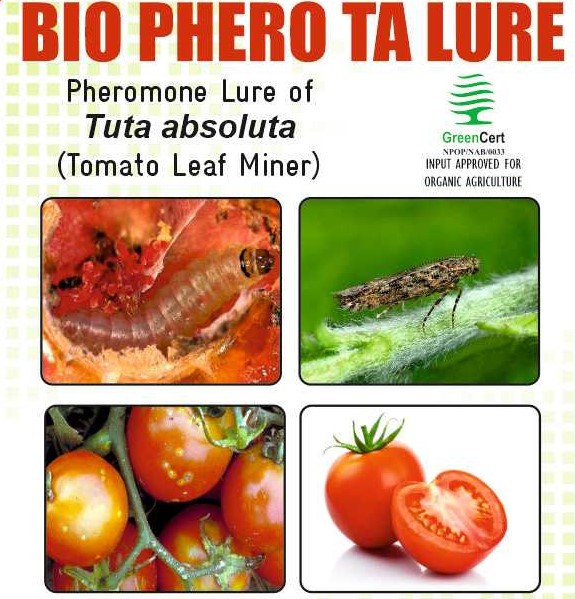




SONKUL AGRO INDUSTRIES PRIVATE LIMITED
Lure With Trap
Pheromone lure of Tuta absolute (Tomato Leaf Minor)
Crops: Tomato, Brinjal, Potato, Chilli, Capsicum
Usage Instruction-
Cut open this pack and slide the lure piece outside.
Do not touch the lure by hand.
Fix this lure properly in a trap by sliding it into the hole provided in the delta trap.
Replace the lure at the recommended duration.
Wash hands thoroughly before and after handling the trap and lure.
Discard used lures by burning or burying them underground.
Trap to be used: Delta Trap / Water trap
No. of Traps/Acre: 10 – 12
No of Day: 60 days
Contents:
Pheromone lure of Tuta absolute (Tomato Leaf Minor)
Nature of Damage-
Tuta absoluta is a devastating pest of tomato.
The Larva feeds voraciously upon tomato plants, producing large galleries in leaves, burrowing in stalks, and consuming apical buds and green and ripe fruits.
It is capable of causing a yield loss of 100%. Tomato is the main host plant, but Tuta absolute also attacks other crop plants of the Solanaceae family, including potato, brinjal, chili, capsicum, and tobacco.
The infestation of Tuta absoluta is very challenging to control.
The effectiveness of chemical control is limited due to the insect’s nature of the damage as well as its rapid capability to develop insecticide-resistant strains
Life Cycle-
Tuta absoluta is a micro lepidopteron moth with high reproductive potential.
The life cycle of a leaf miner includes some distinct stages egg, larva, pupa, and adult.
The total life cycle is completed within 30 – 35 days.
The egg stage lasts for 7 days. The eggs tend to be laid on the underside of the leaves of the host plant.
Eggs are small cylindrical, creamy white to yellow 0.35 mm long. Egg hatching takes place 4-6 days after egg laying.
The larva is cream in color with a characteristic dark head. Four larval instars develop.
Larvae do not enter diapause when food is available. The larvae become greenish to light pink in the second to fourth instars.
The larval period is the most damaging period which completes within 12 – 15 days.
After 4 larval instars, the larvae will fall to the ground in a silken thread, ready to begin pupation in the soil.
The pupal stage is of 5 days. Development of pupa takes place in the soil and occasionally on plant parts such as the stem or within mines.
Tuta absoluta can overwinter as eggs, pupae, or adults depending on environmental conditions.
Adult moths of Tuta absoluta are relatively small with a body length of 5 – 7 mm. The body is brown in color with darker flecks of color on each wing.
The most important identifying characters are the filiform antennae (bead-like antennae), silverfish-grey scales, and characteristic black sports present in the anterior wing.
Adults are nocturnal and hide between leaves during the daytime.
Adult females lay eggs on host plants and mature females could lay up to 260 eggs before completing the life cycle.
The stage lasts for 9 days. The adult moth has a wingspan of around one centimeter. In favorable weather conditions, eight to ten generations can occur in a single year.
Crops: Tomato, Brinjal, Potato, Chilli, Capsicum
Usage Instruction-
Cut open this pack and slide the lure piece outside.
Do not touch the lure by hand.
Fix this lure properly in a trap by sliding it into the hole provided in the delta trap.
Replace the lure at the recommended duration.
Wash hands thoroughly before and after handling the trap and lure.
Discard used lures by burning or burying them underground.
Trap to be used: Delta Trap / Water trap
No. of Traps/Acre: 10 – 12No of Day: 60 days
WATER TRAP-
consists of a water trough and a lure holder with a canopy for the pheromone which attracts specific insects. It is easy to assemble on a single pole.
Insects attracted to pheromones fall into the water in the trough, drown, and die. The trap needs to be set up at a height of 3 - 4 feet from ground level for maximum impact. Fill half the trough with water or water mixed with oil or an insecticide and fix the lure into the holder.
The dead insects can be removed from the trap at appropriate intervals and the tub refilled with water or water mixed with oil or an insecticide.
The frequency of clearing the trap depends on the number of catches and level of infestation."